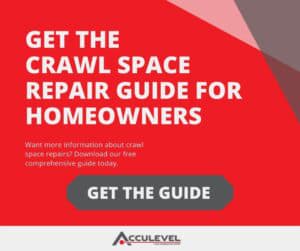Have Moisture In Your Crawl Space?
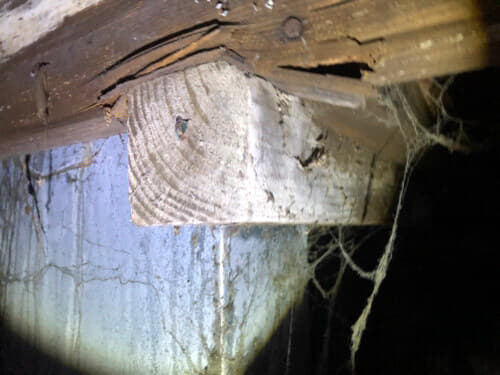
When you hear the word, “moisture,” what comes to your mind? Condensation on a glass? The morning dew on plants? It sounds insignificant, especially compared to words like “flooding” or “standing water.” But what if I told you that moisture could do serious damage to your home and to your health?
Acculevel has been repairing foundations and waterproofing crawl spaces since our start in 1996. Founded by Andy Beery, we are a family owned and operated company based out of Rossville, Indiana. We’ve helped more than 35,000 Midwestern homeowners repair their homes, restoring strength and value to their most crucial investment.
In this article, we’re going to talk about moisture and how this innocuous-sounding element can do significant damage to both your health and your home’s longevity.
Fiberglass Insulation is Not Good for Crawl Spaces
Too often, builders install fiberglass insulation in crawl spaces. This is frustrating, ineffective, and potentially damaging. This type of insulation is difficult to handle and is usually wedged between the floor joists. This isn’t the best way to insulate a crawl space and it eventually fails.
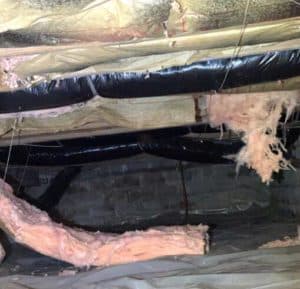
This photo was taken by an Acculevel project advisor during an in-home assessment. The insulation is damp, molding, and falling out of place.
What ruins the insulation is moisture. The fiberglass batting absorbs moisture from the air, like a sponge pulls in water. The moisture weighs down the batting, causing it to sag in place. Eventually, it becomes too heavy and falls.
Damp Insulation Creates Issues for Homeowners
This is an unpleasant situation for several reasons. First, you paid for insulation, but ended up with debris on the ground. Fiberglass batting can attract insects or small animals who are looking for nesting material. (And you know these unwanted guests create their own invasive issues!)
Second, your floors will be cold. There’s nothing insulating your flooring structure anymore, so you’ll be uncomfortable, and possibly bump up the thermostat setting to compensate. This means your HVAC will be less efficient, so it will work hard and run more frequently. You’ll have higher utility bills and more wear and tear on your furnace- neither of these are good for your wallet.
Third, until that insulation falls, it’s holding damp material against the framework of your flooring. The floor joists, band board, and main beam are also going to get damp. Damp wood molds and rots.
To avoid these issues, or prevent them from happening in the future, we recommend that homeowners replace fiberglass with spray foam insulation. It’s water resistant, fills every gap, self-adheres wherever it’s applied, and discourages mold growth.
Sagging Floors Are Often Caused by Moisture
It doesn’t matter if your floor is sagging towards the middle, sloping towards the outside, or is spongy in a specific area; the number one cause of flooring issues is moisture. (A distant second is wood-damaging insects like termites.)
Part of the problem is in the way a crawl space is designed. There’s no proper floor- it’s directly open to the ground under the home. When water seeps through the soil, it can get into the crawl space- even if it’s just moisture evaporating from the dirt. And since a crawl space is (usually) less than 3 feet high, the wooden structure that holds up your flooring is only a short distance away from the water intrusion and/or vapor.
That moisture alone is enough to make the wood damp, and damp wood gradually softens. As wood becomes softer, it can mold or decay. But it can also compress, and your home is very, very heavy.
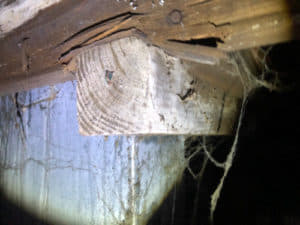
This photo was taken by an Acculevel project advisor during an in-home assessment. The floor joists have softened and decayed; they’re no longer strong enough to resist the pressure of the home. You can see this joist is splintering and crumbling against the support beam.
As the joints compress, decay, splinter, etc., the flooring structure starts to become uneven. If your floor slopes towards the center of your home, this is a sign there’s a problem with the main beam and supports. Sloping towards the outside wall indicates a joist or sill plate issue.
If you have issues with your home’s flooring, this article provides a closer look at the components of your floor’s wooden structure and how repairs are made.
Moisture Corrodes Your Home’s Air Quality
Damp air in your crawl space can encourage unwanted organisms that threaten your air quality. Bacteria, viruses, mold, and other type of biological growth depend on a certain level of humidity to thrive.
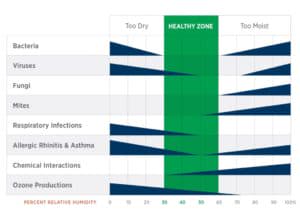
This graph is from a study published by the American Society of Heating, Refrigerating and Air-Conditioning Engineers (ASHRAE). The healthy zone for some things, like bacteria, is a fairly wide range. But allergies and related ailments have a frustratingly small gap. Overall, the ideal humidity level for your home is around the 50% mark.
How Do You Improve Your Air Quality?
There are three steps you can take to combat this moisture and humidity, to dry out your crawl space, and restore healthy air quality in your home.
Crawl Space Waterproofing
If you have standing water in your crawl space- or frequently have water seeping into it -you should install a water drainage system to collect and remove it. The best type of drainage for a crawl space is geochannel, because it’s designed to filter out the soil and debris that are so common in a dirt “floor.” Water moves through the drainage until it reaches the sump pump, which expels the water out of your crawl space via a discharge line.
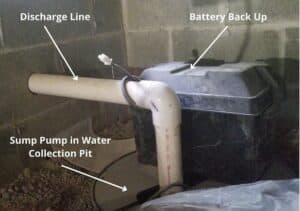
This photo was taken by an Acculevel team member, after installing waterproofing into a customer’s crawl space.
If mold has formed in the crawl space, you’ll need to have this treated and/or removed. Acculevel has a variety of solutions for biological growth, depending on the severity and type of fungus that is present. But you need to address the water intrusion first; otherwise the mold will re-establish itself.
Whole-Home Dehumidifier
Once any standing or regularly intruding water is managed, the next step is to install a quality home dehumidifier. Unlike the smaller appliances you buy at a home goods store, a whole-home dehumidifier won’t need you to regularly empty the water collection “bucket.” This type of dehumidifier has a discharge line that can be routed into your sump pump pit to automatically remove the water for you.
The model Acculevel installs is large enough to cover most homes (up to 5,000 square foot). Our dehumidifier is warrantied for 5 years, can remove 95 pints per day, and has an average life expectancy of 15 years..
Encapsulation Will Thoroughly Dry a Crawl Space
If you want to have a completely clean and dry crawl space, encapsulation is the ideal solution. This process includes installing water drainage (if you don’t already have it), covering the walls and floor with a puncture-resistant liner, and installing a dehumidifier.
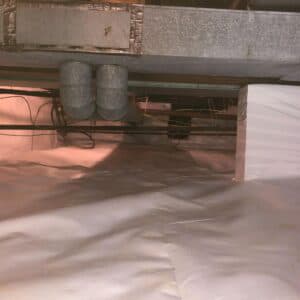
This photo was taken by an Acculevel team member, once encapsulation was completed. You can see the liner covers the walls, floor, and has been wrapped around support columns.
Once the encapsulation is complete, you have a nearly sterile environment. Some of our customers even store out-of-season decorations in their encapsulated crawl spaces. If the access to your crawl space is outside, you can update or replace the current door with one that is insulated to complete the encapsulation process.
Have More Questions about Crawl Space Repairs?
If you want to know more about crawl space problems, causes, repair methods and types, costs, service warranties, and more? Please use our homeowner’s guide to crawl space repairs. This is a free resource that we developed to answer all of the most common questions we received from customers. It is updated regularly as product and repair options change, and we encourage you to bookmark it for future reference.
Do You Need An Expert to Evaluate Your Crawl Space?
Acculevel is based out of Rossville, Indiana and is proud to serve all of Indiana and portions of Illinois, Michigan, Ohio, and Kentucky. If you live in our service area, please give us a call at 866-669-3349.
Do you prefer text or email? Complete our online form and let us know that in the notes! Our scheduling team is happy to accommodate you, no matter what your communication style is.
We will schedule an appointment for you with one of our knowledgeable and experienced project advisors. They will discuss your concerns, the signs or symptoms you’ve seen (or smelled), and thoroughly evaluate your foundation, crawl space, and any other affected areas. Once their assessment is complete, they’ll review the options available, recommend a course of action, and help you develop a whole-home solution that will maintain your home in its best condition for years to come.

